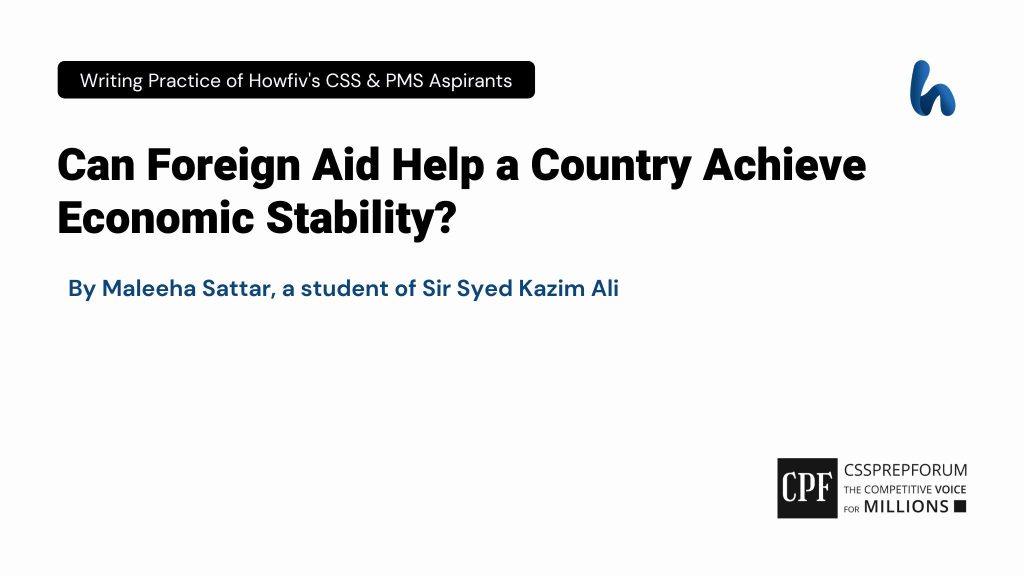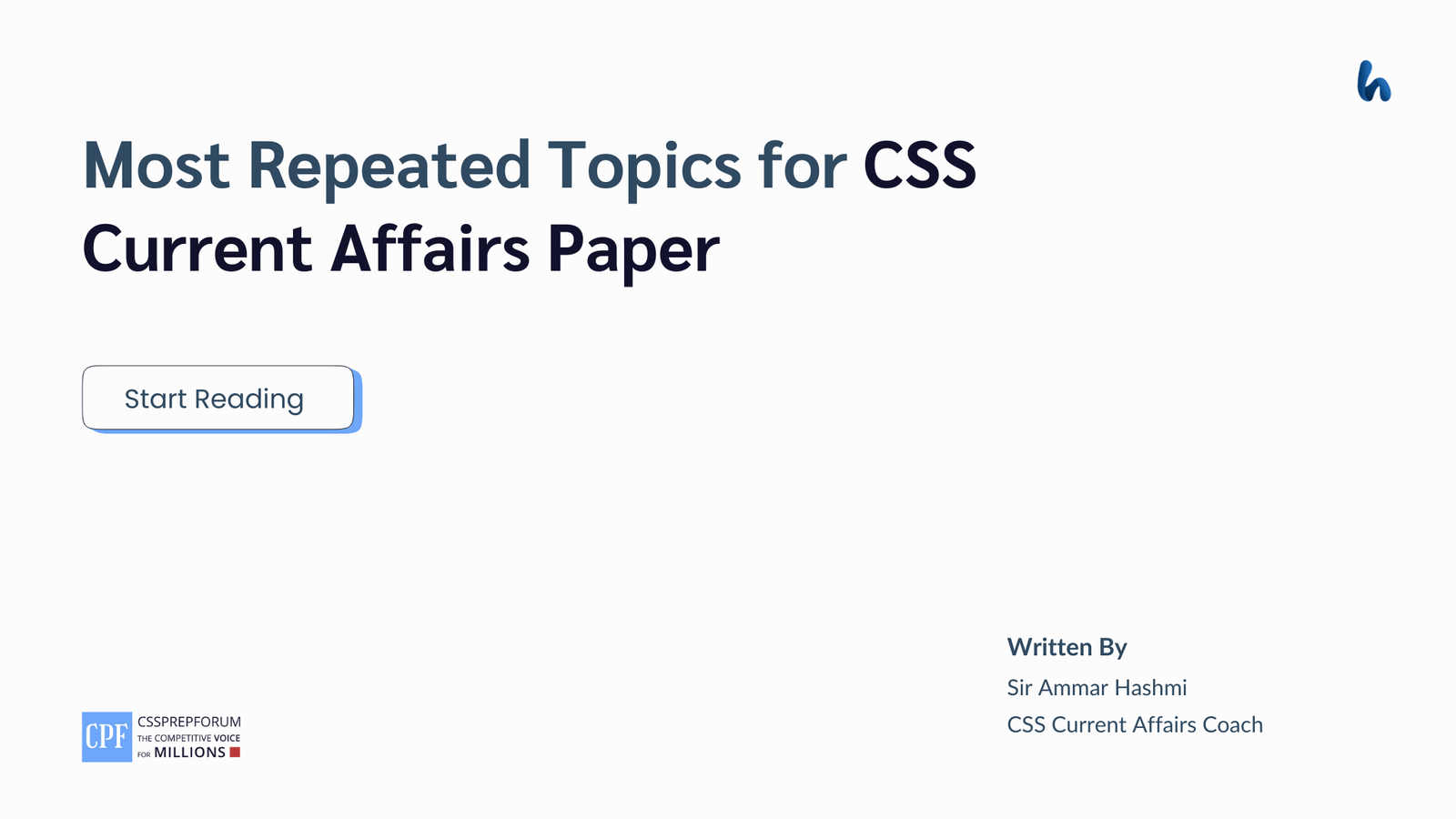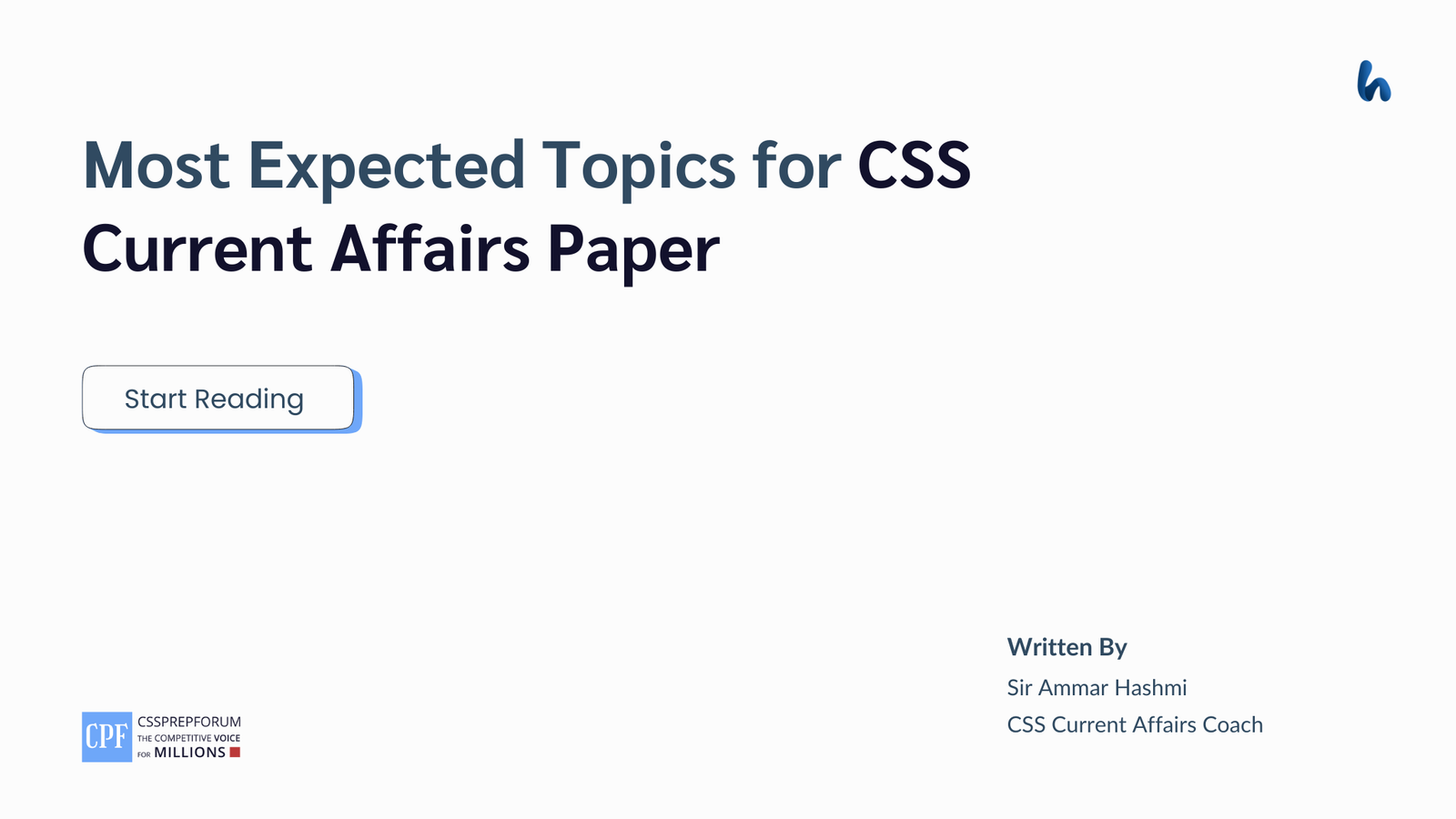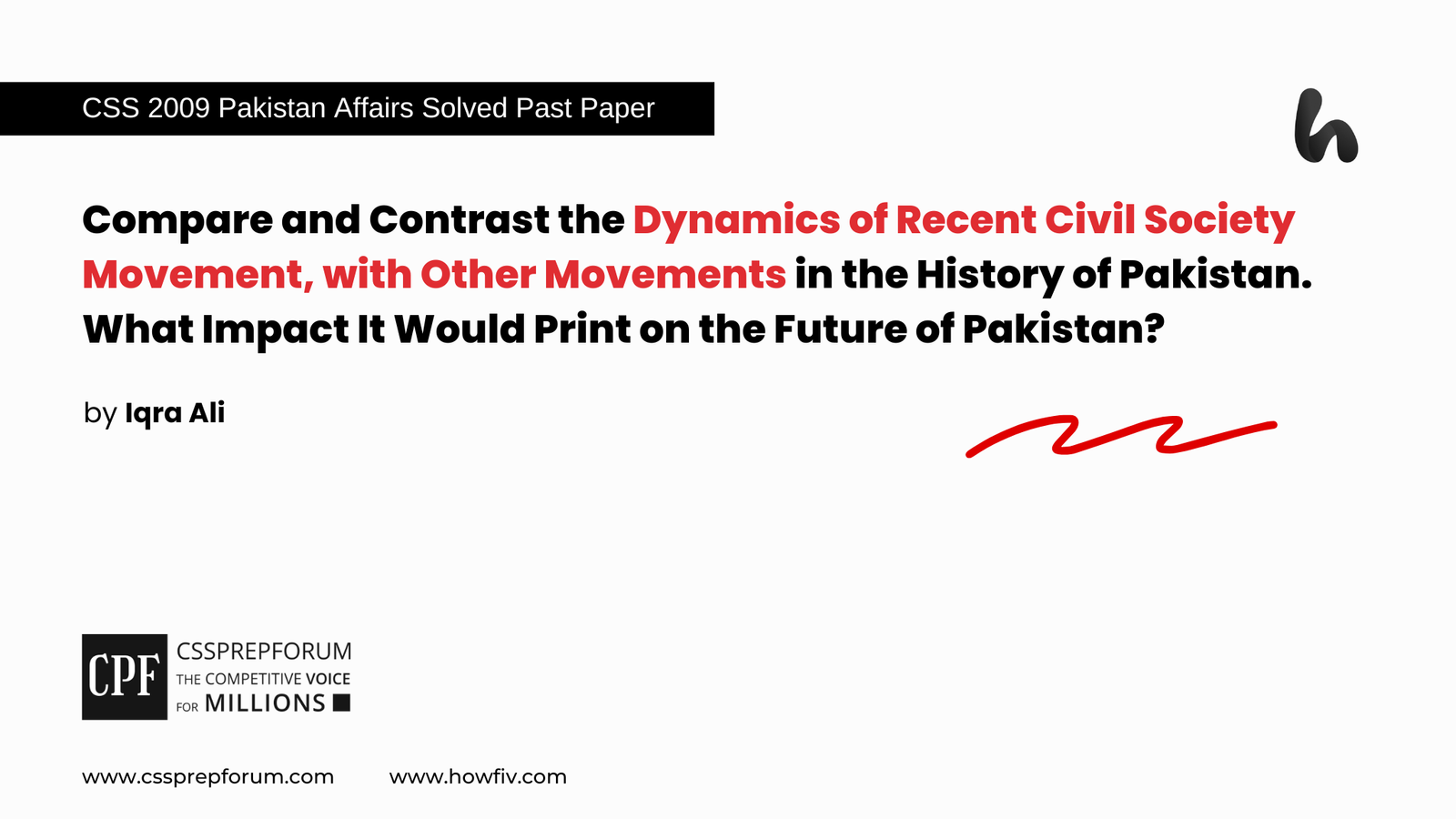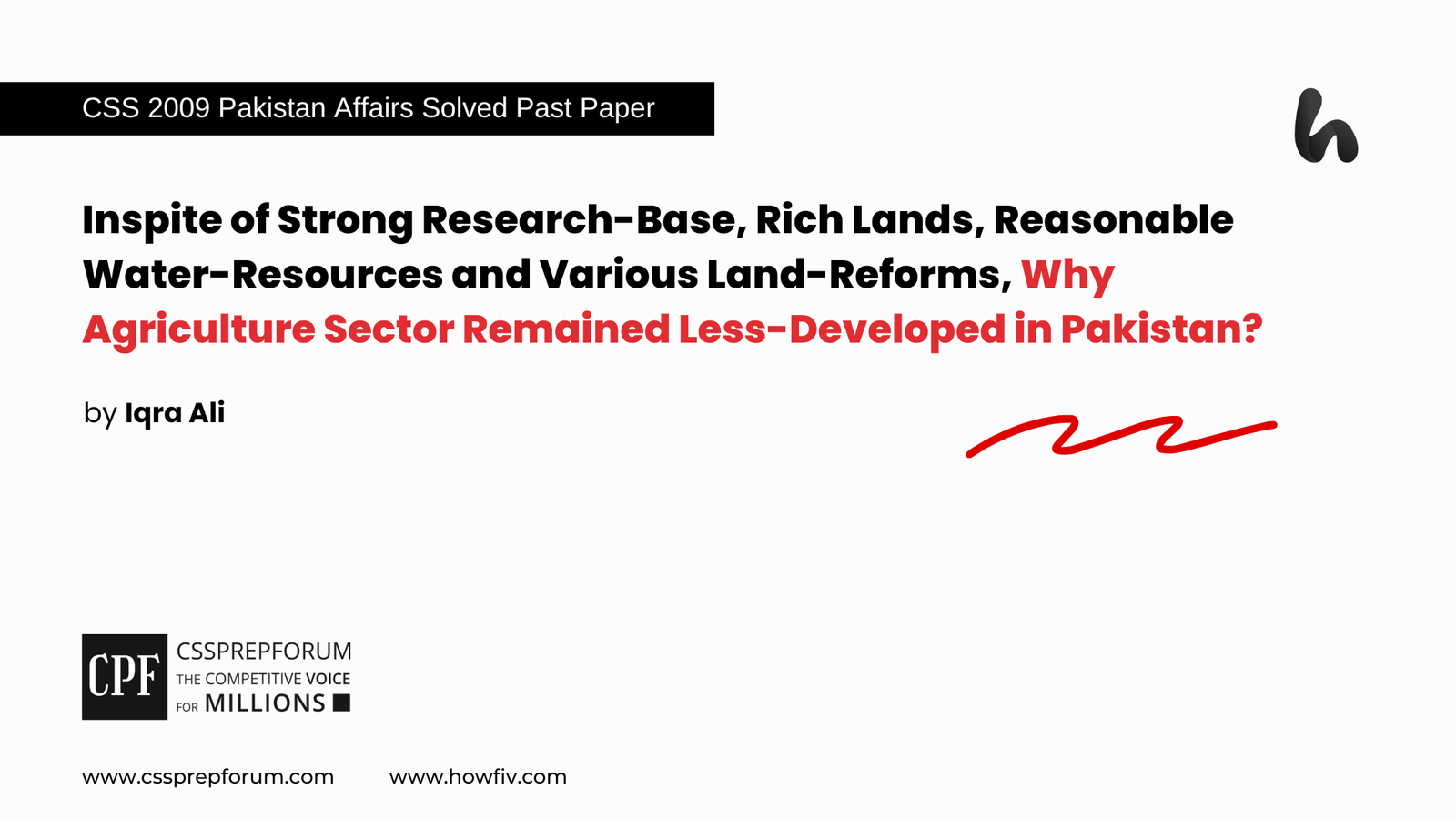The following article is written by Maleeha Sattar, a student of Sir Syed Kazim Ali. Moreover, the article is written on the same pattern, taught by Sir to his students, scoring the highest marks in compulsory subjects for years. Sir Kazim has uploaded his students’ solved past paper questions so other thousands of aspirants can understand how to crack a topic or question, how to write relevantly, what coherence is, and how to include and connect ideas, opinions, and suggestions to score the maximum.

Nothing hampers the economic prosperity of the country the way foreign aid does. Unfortunately, it only provides temporary relief to the sorry state of the developing economies. Many economists believe that foreign aid is synonymous with economic growth because it complements and supplements national resources as well as provides additional financial resources. On the contrary, others argue that foreign aid can replace national savings and also promote aid dependency, which can, in turn, hinder economic and investment growth. In this regard, there is a list of factors that prove economic stability cannot be achieved through foreign aid. First, donor countries provide foreign aid for their economic and security interests rather than to help poor economies. Second, through foreign aid, the donor countries are establishing a new era of colonialism by giving with one hand while taking much more with the other. Next to it, the foreign aid provided by developed nations is mostly military aid, which has no bearing on economic stability. Furthermore, it can lead to the death of local industries; as a result, it is making developing countries beggars rather than resource generators. Last but not least, foreign aid is nothing else than a way to finance corruption and waste, instigate a culture of dependency, and buttress undemocratic regimes and unsustainable economic policies. To add a little further, the case studies of Pakistan, Afghanistan, and Somalia prove that long-term aid is not a path to prosperity but instead a guarantee of failure. Therefore, to achieve economic stability, it is necessary to reverse the assumption that aid is the solution and understand that self-help is more reliable in providing sustained services than foreign aid. Thus, the essay comprehensively analyses why foreign aid has failed to achieve economic stability for developing nations.
Foreign aid is the international transfer of goods, services, or capital from a country or international aid agency to a recipient country or its population. There are many types of foreign aid. The first is humanitarian and disaster relief, which is provided in the case of a tsunami, earthquake, or conflict, causing the displacement and suffering of civilians. Second, the economic aid to sponsor development or investment in infrastructure. The third is military support to assist a country or its people in its defence efforts. In addition, there are healthcare programs involving family planning, reducing infant mortality, or preventing a particular disease. Foreign aid can be further classified into two categories based on who provides foreign aid. Public foreign aid or Official Development Assistance (ODA) that can be bilateral, given by the government of one country to another, such as USAID or the Spanish Agency for International Development Cooperation, or multilateral, provided by one or multiple countries to or through a multilateral agency, such as the U.N., the World Bank or the IMF. Second, private foreign aid or Private Development Assistance (PDA) is provided by NGOs or charity-based organizations, such as the Red Cross or Oxfam.
Before moving toward the factors that prove foreign aid cannot promote economic stability, it is important to understand the relationship between foreign aid and economic stability. Many economists believe that foreign aid contributes positively to developing and less developed countries’ economic growth and development. Bill Gates, the president of the Bill and Melinda Gates Foundation, argues that aid is an effective way for lifting the poor out of poverty. Further, there are several cases where it can be proved that ODA has been very effective in lifting countries out of poverty onto a path of sustainable growth. Europe is an excellent case in point in this context. Europe has in the last two decades experienced an extraordinary number of success stories in moving out of poverty and backwardness, and onto development and sustainable economic growth. Next to it, reference can be made to the cases of Ireland, Portugal, and Greece, and more recently, Bulgaria, Romania, and other new E.U. member countries. Last but not least, once one of the poorest nations in the world and a major aid recipient, South Korea has emerged as the thirteenth largest economy in the world and a major donor country. Throughout South Korea’s rapid development period, foreign assistance played a critical role in producing the country’s miraculous economic growth. In fact, South Korea is one of the very few cases in which foreign aid succeeded in promoting the self-supporting economic development of the recipient country.
Europe, Ireland, Portugal, Greece, Bulgaria, Romania, and South Korea’s cases contrast with many other developing countries in which foreign aid has been largely wasted and failed to bring about the self-supporting economic development of the recipient countries. Despite receiving foreign aid for promoting economic programs over the past decades, some countries have experienced a decline in their real GDP per capita in comparison to a few decades earlier. For example, Zambia’s average income fell from USD 540 to USD 300 between 1964 and 2000 despite getting more aid per capita than any other country. Globally, Africa is the biggest foreign aid recipient. Every year, billions of dollars are sent in as foreign aid and development assistance to Africa with the aim to alleviate hunger, end poverty, foster economic development, democratic governance, and the rule of law without jeopardizing the peace of these countries. Unfortunately, little to no improvements have been made in terms of economic development as Africa remains the poorest continent in the world according to Gross National Income (GNI) and the Human Development Index (HDI). Thus, the foreign aid has failed to achieve the desired results.
The above examples show that in the presence of widespread corruption, instability, and inefficiency of the government, foreign aid has failed to help developing countries. Here, the light will be thrown on some of the factors that prove economic stability cannot be achieved through foreign aid. To begin with, the developed countries provide foreign aid for their economic self-interests rather than helping the developing nations. In this regard, aid is mostly given to develop or expand markets for the donor country’s goods. For example, Timor-Leste, a country in South-East Asia, became independent in 1999. Since then, it has received over $5 billion in aid. Out of this, $2 billion was spent on the U.N. mission alone. Moreover, bilateral donor projects have cost around $1.7 billion. Furthermore, U.N. staff get salaries ten times higher than local staff here. Another good example of this is tied aid, through which the donor country ties the loans to companies within the donor country. In 2018, Japan tied for over 22.4 % or $ 4.2 billion, Germany tied for 15% or $ 3.1 billion, and South Korea tied for more than 48% of its aid. Basically, all these countries promised aid, but instead of giving it to recipient countries, they gave the money to their own companies. So, the aid money is furthering the economic interests of the donors.
Moreover, only a fraction of the total amount promised by the donors actually reaches the recipients, which, again, proves that foreign aid cannot promote economic stability. Audits have shown that 1/5th of foreign aid never leaves donor countries. It either remains in their banks or is given to the NGOs, not to those who need it. In 2019, developed countries raised $100 billion in funds; this was foreign aid to be given to the developing world. Out of this, $22 billion was never transferred. To add a little further, in 2010, Haiti was devastated by an earthquake. The U.S. alone donated $1.3 billion, but the survey shows that NGOs in the country received just 0.9 per cent of the aid disbursed. In 2019, another report was released, according to which 25 % of the aid money given by rich countries is not transferred to developing countries, and the remaining 75% does not reach the recipients directly. Thus, the recipients get only a drop out of the ocean.
In addition to the economic self-interests, a donor country provides foreign aid in order to buy friends and influence, mainly for security reasons. For example, during the Cold War, the U.S. used aid as a way to incentivize countries to side with them instead of the Soviet bloc. Another example that proves that donor countries never provide foreign aid for the economic stability of the recipients is the rise and fall of foreign loan inflow to Pakistan. Pakistan hardly received any assistance in the 1950s. Credit then increased substantially in the first half of the 1960s because of mutual defence agreements (SEATO and CENTO). Following the 1965 war, the assistance was substantially reduced and remained so till the beginning of the Soviet-Afghan war, when it picked up again and continued till the conclusion of the war. It remained so till 9/11 happened. Since then, Pakistan has received a substantial amount of aid. However, now that the withdrawal of coalition forces from Afghanistan is on the cards, voices are again being raised to stop aid to Pakistan. Thus, it again proves that giving aid is in the interest of the donors rather than the recipients, and an unreliable supply of foreign aid cannot promote economic stability.
Further, foreign aid seems to become a continuation of colonialism, which, again, proves that economic stability cannot be achieved through foreign aid. Donor countries offer foreign aid to poor countries while bargaining for the economic influence of the poor or receiving countries for the benefit of the donor countries. It is driven by political considerations and vested interests. For example, many U.S. State Department officials admitted that they consider aid a tool of U.S. foreign policy, a means to advance American economic interests, a means to secure new markets for America, and to establish governments that suit Washington’s interests. In addition, Kenan Malik, making note of former British PM Theresa May, describes foreign aid as a fraud perpetuated by rich countries to bribe or blackmail weaker economies. Thus, instead of fighting inequality and eradicating poverty, it has become a lucrative medium for some in the West to expand their business more than helping the poor.
Furthermore, most of the aid is given to poor countries for military expenses, which has no bearing on economic stability. History tells us that Pakistan’s military dictators have been the biggest receivers of American aid, whether it was the General Zia regime or the General Musharraf regime. Both of these dictators received heavy foreign aid due to the strategic compulsion of the United States, but they never transformed it into public welfare projects. Another example is that of Egyptian military dictator, Fatah Ali Sissi, who received billions of dollars from America but his country kept on going into an economic downslide. Here, most of the funds had been allocated to the security apparatus to curb the mass movement of Hamas Islamists instead of investing in public projects. Thus, foreign aid in the shape of military expenses cannot help a country achieve economic stability.
Besides generating publicity for the donors besides helping the country enhance soft power, foreign aid also kills local industries in developing countries. For example, foreign aid in the form of food aid that is given to poor countries or underdeveloped countries is responsible for the death of local farm industries in poor countries. Local farmers end up going out of business because they cannot compete with the abundance of cheap imported aid food that is brought into poor countries as a response to humanitarian crises and natural disasters. Thus, large inflows of money that come into developing countries from the developed world in foreign aid, increase the price of locally produced goods and products. Due to their high prices, the export of local goods was reduced. As a result, local industries and producers are forced to go out of business, which, again, provides evidence that economic stability cannot be achieved through foreign aid.
To add a little further, foreign aid is nothing else than a way to finance corruption and waste, instigate a culture of dependency, and buttress undemocratic regimes and unsustainable economic policies. This is due to the fact that most of the aid goes into the hands of a few people who use it for their own interests instead of serving the common people. Corruption from the top to bottom in the government machinery in poor countries never allows the aid to go to the lower level for the welfare of the people. Hence, aid-dependent countries tend to have low institutional quality—i.e., they have low accountability, more rent-seeking opportunities, scare away talented people from the bureaucracy, and reduce pressure for them to reform inefficient policies and institutions. Professor Deaton, an expert on global poverty and foreign aid, aptly said, “Foreign aid does more harm than good. It corrupts government and rarely reaches the poor.” Thus, high aid levels promote corruption and reduce the quality of institutions instead of promoting economic stability.
Last but not least, foreign aid is making developing countries beggars rather than resource generators. For example, foreign aid promotes aid dependency while serving as a side source of income for political elites in recipient countries. According to Bauer, an Economist, “Development aid is not necessary to rescue poor societies from a vicious circle of poverty. Indeed, it is far more likely to keep them in that state. It promotes dependence on others. It encourages the idea that emergence from poverty depends on external donations rather than on people’s own efforts, motivation, arrangements, and institutions.” Thus, foreign aid is increasing dependency instead of promoting economic stability.
The above-discussed factors prove that economic stability cannot be achieved through foreign aid. Here are some of the case studies to further support the fact that foreign aid has failed to promote economic stability in developing nations. The first is the case of Pakistan. Despite receiving huge amounts of foreign aid, Pakistan has failed to reach the stage of self-sustaining economic growth. In fact, most of the economic aid has been used to pay off debts. Out of the total disbursement of $77.78 billion to Pakistan during 1961-2021, $45.05 billion (58 per cent) was returned to the donors as payment of previous debts. Unfortunately, the lack of capacity in Pakistan’s administration has led to the deterioration of income distribution, widespread corruption, increased instability, and the inability to efficiently spend billions of dollars of aid. On the other hand, some of the foreign aid made to Pakistan has been spent to realize the aims of the international countries, and some of the promised financial assistance has not been paid. Thus, in the case of Pakistan, rather than promoting economic growth, aid encouraged corruption, perpetuated poor economic policies, postponed reforms, and reduced both domestic private and public savings.
The next is the case of Afghanistan, which shows that aid is not a path to prosperity but a guarantee of failure. Despite the fact that Afghanistan has been receiving hundreds of billions of dollars of foreign aid since the 1970s, the impact of foreign aid on economic growth and, particularly on the per capita income of Afghanistan, has been negligible, and most of its population is still living below the poverty line. The rate of development seems misaligned with the level of foreign aid provided to the country. For example, despite $775 million in humanitarian aid from the U.S. government, half of the population remained hungry. For more than 20 years, a foreign-aid establishment of government bureaucrats, United Nations experts, contractors, and aid agencies has utterly failed to help Afghans gain any semblance of self-sufficiency, leaving behind a failed state and Asia’s poorest country. Thus, Afghanistan is becoming aid-dependent, a fact causing negative consequences both economically and politically.
In addition to Pakistan and Afghanistan, another case study that shows economic stability cannot be achieved through foreign aid is that of Somalia. It is one of the foremost recipients of foreign aid in the world, with over USD 55 billion received from 1991 till date, and paradoxically, it remains one of the poorest countries in the world. Foreign aid in Somalia has fueled corruption and incapacitated Somalia’s economy. For example, in 2011, the Public Management Unit disclosed that approximately USD 30 million in government funds, as well as USD 70 million from Arab donors, had gone unaccounted for from Somalia’s treasury. In addition, the United Nations Group on Somalia and Eritrea (SEMG) reported that 70 per cent of foreign aid allocated for development between 2009 and 2010 had been embezzled. These incidents, amongst others, drove Somalia to be the most corrupt nation according to the Corruption Perception Index from 2014 till date, where Somalia ranks 180 out of the 180 countries in the world that were surveyed in 2018. The Government of Somalia has taken advantage of the dire situation to misuse foreign aid for personal gain rather than putting it toward bettering the conditions of its populace, and its institutions, and strengthening its rule of law. Thus, foreign aid promoted corruption instead of economic stability.
However, foreign aid has failed to achieve economic stability for developing nations. But there is still some light at the end of the tunnel to hit the jackpot. What should be kept in mind is that it isn’t going to be a meteoric rise for the struggling economies to be out of the woods in the near future. In this regard, aid dependence can be overcome only by restructuring the economy through an institutional change that enables the middle class and the poor to participate in the process of savings, investment, and innovation. In addition, there is a need to reverse the assumption that aid is the solution and understand that self-help is more reliable than foreign aid in providing sustained services. Furthermore, poor countries should be allowed to give subsidies and tariffs to develop their economies. To add a little further, mobilizing resources, bringing back the billions parked abroad, reforming institutions, improving governance, purifying politics, and broadening the tax net can help developing countries achieve economic stability. To cut a long story short, there is a need to understand that trade, not aid, is a solution to the problem.
After an examination of the impact of foreign aid in Pakistan, Afghanistan, and Somalia, it is worth noting that foreign aid in itself is not a problem; the circumstances, method of distribution, and use by the recipient country are the problems. In addition, foreign aid on its own does not have a positive impact unless the recipient country’s environment is stable. Therefore, to put an end to the negative effects of foreign aid, it is imperative that there should be conditionality linked to the provision of aid. However, in any case, long-term aid is not the path to prosperity or stability but instead a guarantee of failure. Thus, foreign aid is ineffective and indecisive in boosting the economic progress and development of a country. It is interesting to note that developed countries such as South Korea, the U.K., and Japan strive to hand over the potentially growing economy to their posterity. They, too, remain in the throes of financial shocks, but these states do not spread begging bowls so that their future generations do not face financial obstacles. On the other hand, the above-mentioned developing nations are leaving a debt-ridden economy for their upcoming generations. They failed to understand that aid is not a noble deed to help those in need; it’s a business model where any benefit to the poor is incidental.
To cap it all, it is no exaggeration to say that the one who gets the most benefit from the foreign aid is the donor, not the recipient. In addition, sound policy and good economic management of the recipient matter more than foreign aid. By and large, without good governance and pragmatic financial policies, foreign aid is likely to have a detrimental impact on the economic progress of the recipient country. Since most of the developing and underdeveloped nations are politically corrupt, most of the foreign aid is diverted to the pockets of the political elite. Hence, the claim that foreign aid helps a country achieve economic stability does not hold water, especially when the recipient country’s environment is not conducive to growth.

CSS Solved Past Papers’ Essays
Looking for the last ten years of CSS and PMS Solved Essays and want to know how Sir Kazim’s students write and score the highest marks in the essays’ papers? Then, click on the CSS Solved Essays to start reading them.
CSS Solved Essays
CSS Solved General Science & Ability Past Papers
Want to read the last ten years’ General Science & Ability Solved Past Papers to learn how to attempt them and to score high? Let’s click on the link below to read them all freely. All past papers have been solved by Miss Iqra Ali & Dr Nishat Baloch, Pakistan’s top CSS GSA coach having the highest score of their students. General Science & Ability Solved Past Papers
Articles Might Interest You!
The following are some of the most important articles for CSS and PMS aspirants. Click on any to start reading.

